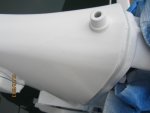2hullsonemarinaberth
Active Member
My boat has now been out of commission since July, mainly as the result of an outboard repaint disaster.
The short version of the problem is basically that the engineer working on my outboards had to repaint one that had a broken steering arm replaced (different colour), some cover damage, and some paint loss around the waterline. The ouboard was resprayed, and was about to be refitted after a couple standing when suddenly all the paint looked like crazy paving, with cracks everywhere. The engine was again rubbed down, cleaned, resprayed and refitted by the engineer. The boat was relaunched, and within two days the outboard had crazed again.
The engineer has since had some advice that a) its not a paint compatability issue, b) different primer sealers have been used with the same end result, c) that the problem is silicone polish on the outboard which is not removed by a normal rub down with wet and dry and an acetone wash, d) after again rubbing down to bare alloy apparently the primer will not adhere, and the only solution is to sodablast the whole engine, e) that sodablasting leaves dangerous residues that may remain on boat, outboard fittings etc and cause further damage, and f) beadblasting may well damage the leg.
As you can imagine I am pulling my hair out after not having use of the boat since the end of June and urgently need some expert advice as to how to move forward from here.
If I can locate some photos I will add them.
Can somebody who knows about this type of issue please advise?
The short version of the problem is basically that the engineer working on my outboards had to repaint one that had a broken steering arm replaced (different colour), some cover damage, and some paint loss around the waterline. The ouboard was resprayed, and was about to be refitted after a couple standing when suddenly all the paint looked like crazy paving, with cracks everywhere. The engine was again rubbed down, cleaned, resprayed and refitted by the engineer. The boat was relaunched, and within two days the outboard had crazed again.
The engineer has since had some advice that a) its not a paint compatability issue, b) different primer sealers have been used with the same end result, c) that the problem is silicone polish on the outboard which is not removed by a normal rub down with wet and dry and an acetone wash, d) after again rubbing down to bare alloy apparently the primer will not adhere, and the only solution is to sodablast the whole engine, e) that sodablasting leaves dangerous residues that may remain on boat, outboard fittings etc and cause further damage, and f) beadblasting may well damage the leg.
As you can imagine I am pulling my hair out after not having use of the boat since the end of June and urgently need some expert advice as to how to move forward from here.
If I can locate some photos I will add them.
Can somebody who knows about this type of issue please advise?

